The New Climate Denial
Air Date: Week of January 26, 2024
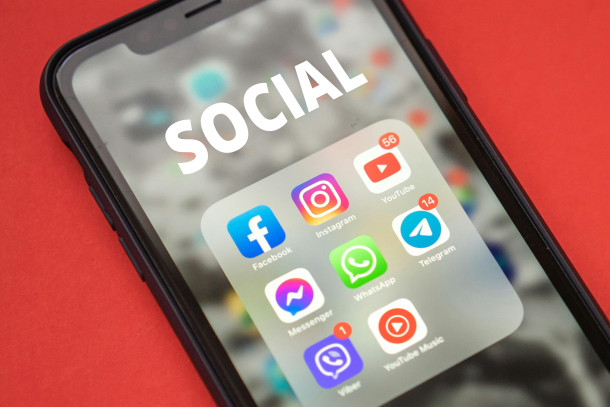
Social media platforms are making it easier than ever to promote climate disinformation. (Photo: Oleksandr P., Pexels)
A recent report finds that social media platforms like YouTube are amplifying and sometimes profiting from new forms of climate denial that falsely claim it’s too late to act on the climate crisis. Imran Ahmed is the CEO and founder of the Center for Countering Digital Hate and joins Host Steve Curwood to talk about how climate disinformation has evolved from attacking science to attacking solutions.
Transcript
DOERING: We continue our series on climate change disinformation with a look at how climate denial has evolved in just the last few years. Climate science has been under attack for decades. But some climate deniers are no longer refuting the fact that the Earth is warming because of human activity. Now their message focuses on doom. They admit our planet is running a fever, but shrug and say there’s not much we can do about it. A new report from the Center for Countering Digital Hate takes a close look at this new form of climate denial and how it shows up in videos on one of the internet’s most popular content sharing platforms, YouTube. And when ads run on those videos, the climate deniers and YouTube often pocket the profits. Imran Ahmed is the CEO and founder of the Center for Countering Digital Hate, and he joined Living on Earth host Steve Curwood to share the findings.
CURWOOD: So how long did you work on this study looking at how social media is, in some cases, maybe many cases, promoting disinformation about climate change?
AHMED: Well, this has actually been one of the longest and most complex studies we've ever done. We had to work with university researchers who have developed an AI model that allows them to identify, to actually schematize and work out what type of climate denial claim is being made in this piece of text. What we used that tool to do was analyze thousands of hours of YouTube videos produced by prominent climate deniers and study the evolution of the types of claims they've been making between 2018 and 2023. And what we saw was startling: a real collapse in the volume of claims being made that anthropogenic, so manmade climate change, is not happening, that either it's not happening at all or that it's not manmade, and an explosion in the volume of claims that, you know what, climate change may be happening, but the solutions don't work. So climate deniers have transitioned from the old climate denial, which is rejecting anthropogenic climate change, to a new climate denial, which is casting doubt on solutions.
CURWOOD: So talk to me more about this question of old denial and new denialism. Your report says that climate denial folks have moved beyond trying to say that climate change isn't happening and humans aren't related to this. But moving into the area that the solutions won't work, why is that new? Because from day one, people opposed to climate action said, oh, it costs too much, that won't work, the technology is too expensive, and you know, we're gambling way too much on "iffy" technology. What's new about the kind of, what you call new denial?
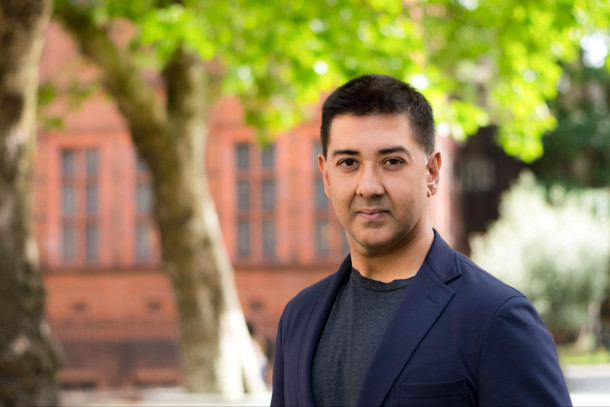
Imran Ahmed is the CEO and founder of the Center for Countering Digital Hate. (Photo: Courtesy of CCDH, Imran Ahmed)
AHMED: So it's really the focus that we're looking at here. As solutions have developed to become more sophisticated, as the world has become more convinced of the dangers of climate change, as political actors and as companies and as others have taken action, what you have seen is the battleground shifting. And so in 2018, over two thirds of all the claims made were rejecting the reality, the scientific consensus, on climate change. Now, that's less than three in 10. So less than a third. And what is now two thirds of all claims made is these other forms of denial. The three major families in the new denial are: that climate solutions won't work, that the impacts of global warming are beneficial or harmless, or that the climate science and the climate movement are unreliable. Because let's be absolutely frank about this. This has never been a debate about the science. This has been a debate between scientists and those who want to stop action being taken on climate change because that would destroy the oil and gas industry. And they are implacably opposed to climate solutions being put in place. They don't care whether it is by persuading people that climate change isn't real, or even more cynically, by dashing their hope that climate change can be dealt with.
CURWOOD: So how do they sell this notion that nothing can be done about climate through social media? How do they tell that story?
AHMED: You know, one of the things that you learn after studying disinformation and conspiracy theories and this kind of content over years and years, as my team has, not just in climate, but also public health, is that underpinning every conspiracy theory, every bit of misinformation, is fundamentally a lie. The lie is that there's nothing we can do about it. The lie is that solar power, that wind power, that tidal power, that switching to electric vehicles, couldn't substantially help to mitigate the worst ravages of climate change. But what they then claim is that well, sure, you might want to switch to an EV. But did you know that throughout the supply chain of an EV, in that creating that EV actually uses more CO2? Now, that's actually nonsense. It's been shown by the EPA and by a raft of scientists that actually the lifetime emissions of an electric vehicle is significantly lower. But what they're doing is, they're selling a lie, which is, don't buy an EV because it's worse for the environment.
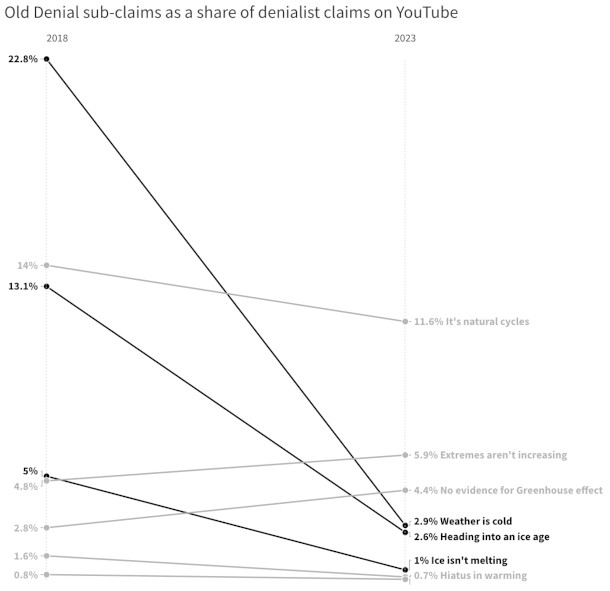
“Old Denial” claims, which reject the reality of anthropogenic climate change, no longer make up the majority of denialist claims on the YouTube channels studied. (Photo: Center for Countering Digital Hate)
CURWOOD: Let's talk about how this social media works in part to appeal to a sense of "doomerism" among young people, that, yeah, well, climate's a problem, but hey, we're over the edge. So we might as well party until the asteroid or whatever hits.
AHMED: Well, I can't think of anything more cynical, can you, than telling young people that, yes, the world's climate is changing in potentially catastrophic ways, but there's no hope, and nothing that you can do could help, so may as well live with it. You know, we did some polling to go alongside this study, just to check what the acceptance levels are of different types of climate denial with young people. What we found is that acceptance of the old climate denial is incredibly low. What's been replacing it is more acceptance of the new climate denial. But you know, I think that there is a really important message here. Science won that first battle. Scientists, journalists, politicians, communicators have persuaded and explained to the public and young people that climate change is real. But the opponents of action on climate change have opened a new front. It's vital that this message is heard by the climate advocacy movement, because we're going to have to refocus our efforts, our counternarratives, our resources on explaining why climate solutions are viable, how we can save our planet and save our ecosystems.
CURWOOD: So talk to me about what these videos look like, how they feel. I mean, what kind of strategies are these YouTubers using to make their information seem legit?
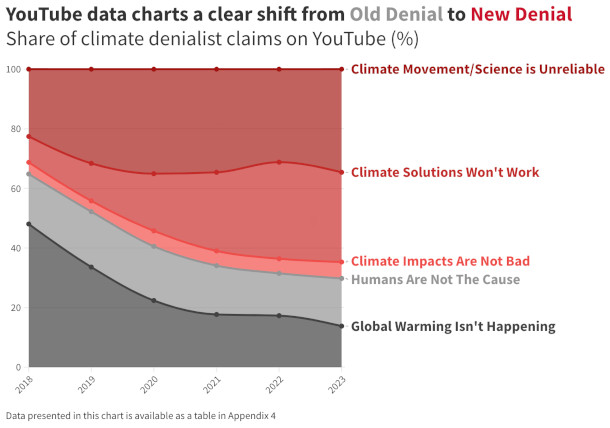
“New Denial” claims now dominate the YouTube channels studied. (Photo: Center for Countering Digital Hate)
AHMED: Well, they bring on experts. They have the appearance of academic or research neutrality, they have visuals, graphs. Sometimes the presenters even wear a tweed jacket to make it look as though they're erudite. It's a trick I have used in the past myself. And cherry-picked data, which is not representative of the whole. So all the tricks that you expect from shysters and snake oil salesmen. It's a toxic mélange of lies and truth that make it very difficult to discern what on earth is going on, often delivered at, you know, a fevered pace that, if you're trying to fact check it, you're overwhelmed by the next lie before you've even, you know, managed to consume or work out the truth behind the last lie. It's a sophisticated industry, and they learn from each other. They learn from other sectors. There is an enormous amount, as you will know, of disinformation around public health, around vaccines. I mean, one of the things that we always find with this is that there is an asymmetry when it comes to disinformation. You know what, it takes no effort at all, it takes no science, it takes no education, it takes no thinking to actually come up with a lie. The problem is that debunking that lie often requires effort, it requires expertise, it requires resources. And so you get this asymmetric tidal wave of disinformation, in particular on social media, because social media is the environment where bad actors can not just promulgate, can not just spread this disinformation, these lies, very easily. But also, ironically, they get amplification, and they get economic reward for it. So they get amplification because people engage with that content, often in anger, saying this is nonsense. But that actually signals to the platform, this is high engagement material, and they publish it to more and more people and more and more timelines. But second, the platforms, like YouTube in our study, place ads on this content. Those ads make money for YouTube, millions of dollars a year, in spreading disinformation about climate, but also for the producers as well, who get a take of all of that. So actually, there is this sick industry that is profiting from making people feel there is no hope on climate change.
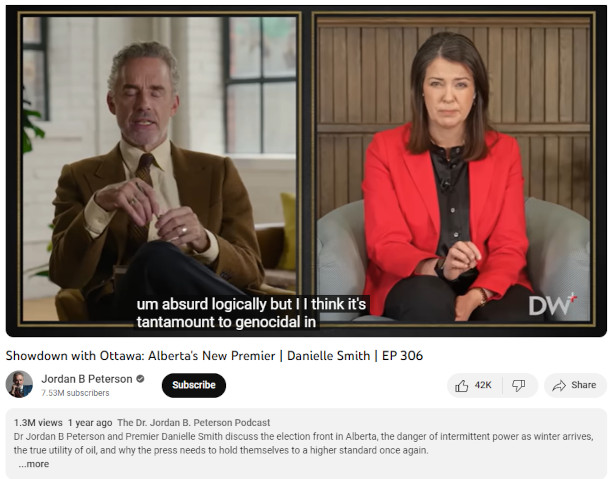
“New denial” claims cast doubt on climate solutions and the climate movement. In this video Jordan Peterson interviews Canadian politician Danielle Smith. While in conversation he says, “In the terms that the environmentalists themselves hypothetically hold dear, the idea that we can make the planet more habitable on an environmental, on the environmental front by impoverishing poor people, by raising energy prices and food prices, is absolutely, it’s not only absurd logically, but I think it’s tantamount to genocidal.” (Image: Screenshot of Jordan Peterson video, courtesy of Center for Countering Digital Hate)
CURWOOD: So what kind of money are we talking about, with the millions of dollars of ads in social media?
AHMED: So just looking at the 100 channels that we studied, and there are thousands more, of course, but the 100 that we studied, which was 12,000 videos, 4,000 hours of content that we studied, that's worth around $13.4 million, we estimated, a year. Now that's using figures which are freely available, you know, on how much an ad costs, how often those ads appear, et cetera, et cetera. We don't know precisely what the split is, but it's about 55 to 45, 60 to 40, for the content creator and the platform. So both of them are profiting lavishly from this kind of content. What we will find, though, is that there'll be other channels around as well. So actually, these numbers are a very, very small estimate of the channels we looked at. We could be talking about $100, $200 million industry in total.
CURWOOD: Yeah, I was going to ask, did you look at the advertisements that happened on Facebook, and other social media that's out there?
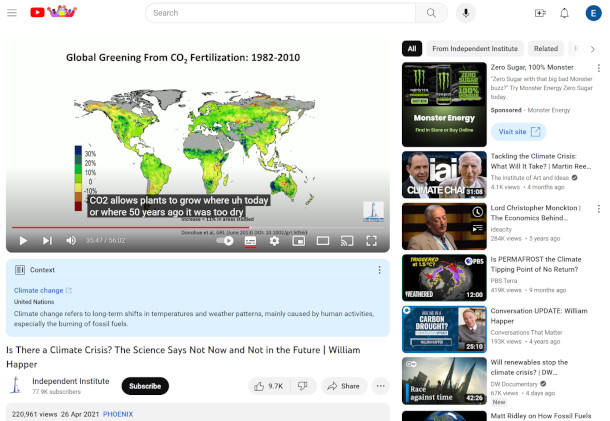
Other “new denial” claims argue that CO2 has positive effects. These screenshots show ads for Monster Energy served on and next to a video from the Independent Institute promoting the claim that CO2 has been beneficial for greening, saying: “The western United States is greening, western Australia is greening, western India is greening and this is almost certainly due to CO2. And the reason this happens is that CO2 allows plants to grow where today or where 50 years ago it was too dry.” (Image: Screenshot of Independent Institute video, courtesy of Center for Countering Digital Hate)
AHMED: You know, this initial study was based on YouTube because it's a platform that we were able to study using this tool very easily. However, we are absolutely certain that this is happening not just on Meta platforms, so on Facebook, on Instagram, on TikTok*, but also on X, which is owned by Elon Musk, a man who recently claimed that no human being on earth has done more for the planet than he has, but at the same time runs a platform that is rife with disinformation about climate, and that is helping to undermine the consensus that we need for action to be taken to mitigate climate change.
CURWOOD: What about the issue of censorship, though? I mean, everyone does have a right to free speech, not the right to shout "fire" in a crowded theater, but we have pretty strong free speech rights. Where do you think the limits should be set on this kind of information?
AHMED: Everyone has absolutely the right to hold opinions, no matter how ridiculous or counterfactual they are. People can post it if they want to. But not everyone has a constitutional right to profit from it, nor do they have a right to have a megaphone handed to them so that they can scream it to a billion people. And that's the issue here. Censorship is about the government saying that you're not allowed to say something. A private company has every right to say, I'm not gonna give you money for the content that you've just produced. That's not censorship. That's just not paying people for what they say. And so this isn't a question of censorship. This is a question of rewards. Look, in the past what YouTube has said, and this is their own rules, not my rules, their own rules, that they've said that they will not put ads on, nor will they amplify climate denial content that goes against the scientific consensus on climate change. Now, what we found was, first of all, that they're not sufficiently enforcing that policy anyway. And they responded to our study by saying, whoops, you're right, we'd better take the ads off these videos that you found. But second, we've said they should extend their policy, which only applies to the old denial, to the new denial, too. You simply cannot be calling yourself a green company, and then commit the stultifying hypocrisy of both profiting from and amplifying to billions, climate denial content.
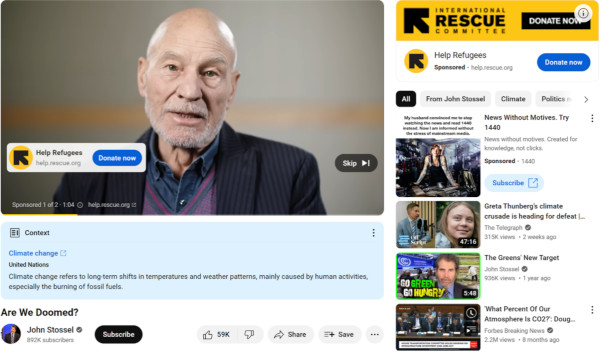
While YouTube says it does not monetize “old denial” claims, the CCDH found the policy was not fully enforced. These screenshots show ads for the International Rescue Committee served on and displayed next to the video “Are We Doomed?” from John Stossel. In the video, Stossel moderates a panel with members of denialist think tank The Heartland Institute, where one member claims, “There is no relationship between hurricane activity and the surface temperatures of the planet.” (Image: Screenshot of video by John Stossel, courtesy of the Center for Countering Digital Hate)
CURWOOD: To what extent can government play a role here in cleaning up social media? And to what extent is this just something that the free market is going to have to do?
AHMED: I think governments can mandate transparency of companies, so they explain how their algorithms work. They explain how their content enforcement rules work. I think they can explain how their economics work, how the advertising works, so we have more understanding of that as well. And you know, one of the biggest problems that advertisers have, is they often don't know where adverts are appearing. Do you know what sorts of organizations were appearing on these climate denial videos? The United Nations High Commission for Refugees, Save the Children, the International Rescue Committee. Three bodies which are dedicated to dealing with climate change were accidentally having their ads appearing on these climate denial videos. And they will be furious. And I think that when the market has more transparency, when people identify problems, as our research does, then I think that people will take action.
O’NEILL: That’s Imran Ahmed, CEO and founder of the Center for Countering Digital Hate. He spoke with Living on Earth host Steve Curwood. We reached out to YouTube for comment and received a response from a YouTube spokesperson that reads in part: “Our climate change policy prohibits ads from running on content that contradicts well-established scientific consensus around the existence and causes of climate change.” The full statement is on the Living on Earth website, loe.org, where you can also find the rest of our climate disinformation series.
Full YouTube Statement: “Our climate change policy prohibits ads from running on content that contradicts well-established scientific consensus around the existence and causes of climate change. Debate or discussions of climate change topics, including around public policy or research, is allowed. However, when content crosses the line to climate change denial, we stop showing ads on those videos. We also display information panels under relevant videos to provide additional information on climate change and context from third parties.” - YouTube Spokesperson
*Editor’s Note: To clarify, TikTok is not owned by Meta.
Links
Living on Earth “Part I” Fossil Fuel Deception with Naomi Oreskes
Living on Earth “Part II” Climate Deception with Naomi Oreskes
Find YouTube parent company Google's climate change policy here
Living on Earth wants to hear from you!
Living on Earth
62 Calef Highway, Suite 212
Lee, NH 03861
Telephone: 617-287-4121
E-mail: comments@loe.org
Newsletter [Click here]
Donate to Living on Earth!
Living on Earth is an independent media program and relies entirely on contributions from listeners and institutions supporting public service. Please donate now to preserve an independent environmental voice.
NewsletterLiving on Earth offers a weekly delivery of the show's rundown to your mailbox. Sign up for our newsletter today!
 Sailors For The Sea: Be the change you want to sea.
Sailors For The Sea: Be the change you want to sea.
 The Grantham Foundation for the Protection of the Environment: Committed to protecting and improving the health of the global environment.
The Grantham Foundation for the Protection of the Environment: Committed to protecting and improving the health of the global environment.
 Contribute to Living on Earth and receive, as our gift to you, an archival print of one of Mark Seth Lender's extraordinary wildlife photographs. Follow the link to see Mark's current collection of photographs.
Contribute to Living on Earth and receive, as our gift to you, an archival print of one of Mark Seth Lender's extraordinary wildlife photographs. Follow the link to see Mark's current collection of photographs.
 Buy a signed copy of Mark Seth Lender's book Smeagull the Seagull & support Living on Earth
Buy a signed copy of Mark Seth Lender's book Smeagull the Seagull & support Living on Earth

